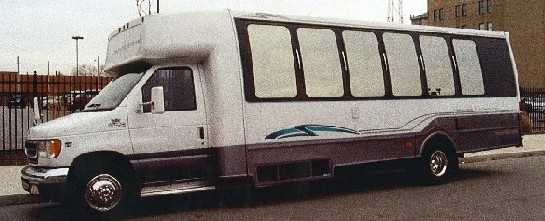Home of the Looooongest Limousine in Cleveland Ohio
Specializing in White Stretched Limousines, Lincolns, and Super Streeeeetched Limousines, and V.I.P. SUVs and Coaches.

"WE GUARANTEE OUR SERVICES"
"Our Main Priority is a Satisfied Customer"
OUR GUARANTEE IS:
The car will arrive neat, clean, and in good operating condition.
Drivers will be neatly dressed and well mannered.
SERVICES AVAILABLE FOR:
- CONCERTS & CONCERT PACKAGES
- WEDDINGS • BACHELOR • BACHLORETTE PARTY
- PROMS • HOMECOMINGS
- EXECUTIVE BUSINESS MEETINGS
- BANQUETS • SIGHT SEEING TOURS
- SPORTING EVENTS
- CLASS OR FAMILY REUNIONS
- THEATER • DINNER PARTIES
- OFFICE PARTIES
- LUXURIOUS LONG DISTANCE TRAVEL
- NIGHT OUT • DESIGNATED DRIVER
- AIRPORT SERVICE
SEATING CAPACITIES FOR 6, 8, 10, 12, 14, OR
20 PASSENGER COACH
History of Lincoln Limousines
Since 1923, Lincoln became the official car of American presidents. Looking ahead, we should note that the first persons of the USA drove Lincoln limousines for 60 years, and only under Reagan they were replaced by Cadillacs. Lincoln was used by the royal houses of Norway, Sweden and Romania. A large batch of cars was purchased by the Soviet government.
So how did these cars - favorites of presidents - originate? The origin of the Lincoln was Henry Martin Lilnad.
Lincoln cars.
Henry Martin Leland's name has gone down in American automotive history twice. Early last century, Leland founded the Cadillac Motor Car Company. In July 1908, Cadillac became part of General Motors, created by William Crapo Durant. In 1917, Leland left GM and organized a new company, Lincoln Motor, which began with a major government order and produced 6,500 aircraft engines in one year.
In 1920, the first Lincoln Model L debuted in the luxury class, powered by a 5.8-liter 90-horsepower V-8. The attempt to penetrate the "high society" of the American car industry ended in complete failure for Leland. By the summer of 1921, his company suffered a monthly loss of 100 thousand dollars, and sales did not exceed 800 cars per month. And the reason for this was not some technical flaws. Leland's cars were of high quality, but the 74-year-old "Mr. Precision," as Henry was called in engineering circles, paid absolutely no attention to the design of the cars he produced.
The body of the first Lincoln was quite simple and unsightly. And naturally, wealthy people preferred the products of such companies as Peerles, Packard and Pierce-Arrow. By early 1922, Henry Leland's company was on the verge of bankruptcy.
Perhaps the Lincoln brand would have gone into oblivion if not for Henry Ford. On February 4, 1922, he bought the Leland company for $8 million. Edsel Ford, son of the automobile king, became president of Lincoln.
Unlike Leland, Ford Jr. understood the importance of a car's appearance to its market success. Leaving the high-quality "stuffing" unchanged, Edsel did a complete restyling of the cars exterior. As a result, Lincoln got "aristocratic" features peculiar to all later models of the company.
At the same time, the factory buildings, built in a hurry to fill military orders, were rebuilt. A strict system of quality control was established at the factory. For example, dimensional deviations of connecting rods and crankshafts were tolerated within 0.0002 inch. Before leaving the factory, each car was subjected to 177 measurements and tests.
The updated Lincoln L went on sale in late 1922. It was upgraded several times over the years: cast-iron pistons were replaced by aluminum pistons, friction shock absorbers were replaced by hydraulic shock absorbers. In 1926, the famous houndstooth figure on the radiator appeared on the cars, and more efficient Perrot brakes were installed. The engine capacity was increased to 6.3 liters. With the same power (90 hp) the torque was increased. The body is decorated with chrome parts. Thanks to a clever marketing policy the production of Lincoln increased from 2249 cars in 1921 to 8787 in the 26th.
In 1930, the Lincoln L was replaced by the Model K, equipped with a V-8 of the same displacement. Thanks to a dual drop-flow carburetor and a new gasoline pump, power rose to 120 hp. Initially, the trucks were offered on a 135-inch wheelbase. Two years later, new models were produced with the wheelbase shortened by 9 inches.
The same year the first 12-cylinder KV was presented. It was equipped with a V-shaped engine with working volume of 7.43 liters and output of 150 hp. The engine allowed the car to reach an acceleration of up to 160 km/h. This new model had the same proven chassis of the K model with a long base, the same body, gearbox and double-plate dry clutch, as well as hydraulic brakes with vacuum booster.
In late 1932, the Lincoln KA began to be produced with the 6.2-liter 125-horsepower V12 engine mounted on the 136-inch chassis of its predecessor. The introduction of the KA coincided with the peak of the global economic crisis. Many grandees of American car industry left the stage. The Lincoln brand was saved by the fact that it was a part of Ford Motor. Edsel Ford played a major role in its preservation. He timely ordered to prepare for production a relatively inexpensive model Lincoln Zephyr, for he understood that during the economic boom luxury cars would be needed only by a few buyers.
Call Brentwood LimousineToday


